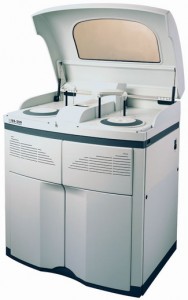What does a chemistry analyzer analyze?
Chemistry tests fall into two broad categories, routine (also called general) and immunochemistry. This article will address routine chemistry testing in a medical practice laboratory and the next installment in this series will cover immunochemistry testing.
Routine chemistries encompass those tests that are measured by any of four methods:
- Mixing serum or plasma with chemicals that create color when they react with whatever is being measured.
- Measuring the effects of enzymes on substrates.
- The use of Ion Selective Electrodes (to measure electrolytes like sodium and potassium.)
- Nephelometry, which is creating precipitates that cause cloudiness and measuring that cloudiness (used much less frequently used than the other three methods.)
The routine chemistry tests that are most often ordered in a physician office lab (POL) are those in these CPT-defined test panels:
- Comprehensive Metabolic Panel (14 tests)
- Basic Metabolic Panel (8 tests)
- Hepatic Function Panel (7 – 9 tests)
- Lipid Panel (4-6 tests)
The most commonly ordered individual tests are glucose, potassium, and total cholesterol.
Design differences in chemistry analyzers
Chemistry analyzers fall into two design categories – benchtop (those that will fit on a counter) and floor models (those that are free standing and sit on the floor). In addition to being described by their size, they are also categorized by their speed of testing – referred to as “throughput”. As a general rule, the benchtop analyzers are not as fast as floor models, but this isn’t always the case. Floor models usually have longer calibration stability periods (which is an important consideration financially) and require a little less hands-on attention by the lab staff (also a financial consideration). Most chemistry analyzers fall into the Moderately Complex category, but there are a few classified as Waived, and some POLs are large enough to need analyzers classified as Highly Complex. The Waived analyzers use whole blood for testing, but Moderately and Highly Complex analyzers use serum or plasma (or urine or body fluids) for most of the tests run.
Determining chemistry analyzer feasibility
As with any other lab test, the feasibility of setting up testing in-office depends on the needs and test ordering patterns of the providers. Getting paid for the testing depends on being able to demonstrate medical necessity for the test(s). Being able to break even or make a profit on chemistry testing depends on:
- the volume of tests ordered
- the cost of the equipment and consumables
- the cost of staff needed to operate the systems.
Step #1: acquire reliable test numbers
If you are reading this, I will assume you are having blood drawn in the practice and picked up by a reference lab. Ask the reference lab to provide a utilization report for the past 6 months. Once the numbers are determined, the number of tests can be multiplied by the reimbursement – the Medicare Fee Schedule is the rate most commonly used for this – to determine potential revenue.
Any sales person trying to sell an analyzer can produce a proposal for the instrument which will include information on the cost of tests and reagents and other consumables, the cost of the analyzer and service for the analyzer, and the potential profit margin. So you don’t have to do all the work yourself, but you do have to have accurate test numbers to produce meaningful information. DO NOT GUESS.
Step #2: cost of equipment and consumables
The size of the analyzer selected and the throughput speed is determined by the number of tests performed and the types of tests performed. A good sales rep can assist with this decision and make recommendations based on the size of the practice, the test menu, and the test numbers.
Benchtop analyzers range from $25K to $75K but expect discounts on the highest prices.
Floor model analyzers range from $60K to $150K.
Because there are so many more factors involved in chemistry testing and instrument selection, many practices opt for using a consultant to prepare an objective feasibility study and assist with selection of the instrument that will be the best fit for your size and needs. It is not nearly so cut and dried as selecting a hematology analyzer.
Step #3: Staffing
The only qualifications needed for staff to run Moderately Complex analyzers are that they have a high school diploma, that they be adequately trained, and that the Lab Director has deemed them competent to perform the tests. Chemistry testing is a little more involved than hematology testing (CBCs) and generally requires more training time to become proficient in using the analyzer, but can be done by staff members other than formally trained laboratorians.
What is the profit margin for chemistry analyzer tests?
Routine chemistry testing generally encompasses a higher operating cost than running CBCs so on a per-test basis it does not provide the same degree of profit margin as hematology does. Waived chemistry analyzers are more expensive on a cost/test basis – so much so that it is often a challenge to break even using them.
Because so many different reagents are used for the many, varied chemistry tests, the test numbers are critical – If you set up an analyzer with too few tests being ordered you will waste reagents because they will expire before you use them up. This greatly increases the cost/test and reduces the profit margin. Another cost consideration is the frequency with which calibration is performed. Calibrations use multiple test measurements and require additional quality control be run, so the more often they are performed, the higher the costs associated with them. Remember that only patient tests are reimbursable tests – calibrations and quality control tests are “hidden” costs that must be covered by the reimbursement for the patient tests.
Some chemistry tests reimburse at higher rates than others, but the tests included in the Comprehensive Metabolic Panel (CMP) and the Basic Metabolic Panel (BMP) are not high reimbursement tests, so it is important that the number of tests being run be adequate to cover the costs of having an analyzer and the costs of the reagents used on it. Lipid Panels reimburse at a higher rate than CMP and BMP and have lower cost/panel as well, so including Lipid Panels in the routine test menu helps in obtaining a positive margin for chemistry.
Do you need chemistry testing in-house?
That is a question the providers can best answer. Often the convenience of having the results available on a stat basis when needed makes introducing chemistry testing into the lab a winner even when the profit margin is not great. In addition to the availability of stat results, the fact that you have control of the sample from collection to reporting is a very positive aspect. Once the sample leaves your premises, you don’t know what happens to it – how it is transported, how it is stored, whether or not the sample i.d. was compromised, etc. So there are many considerations to having in-house chemistry testing capability other than just potential profit.
As with selecting a hematology analyzer, however, it is very important to do the due diligence and obtain a users list for every analyzer under consideration and call as many names on the list as you can manage. It is the users who will give you the most valuable information about the pros and cons of any given analyzer. And don’t forget to ask them “would you buy this analyzer again?” If they say no, move on to something else!



